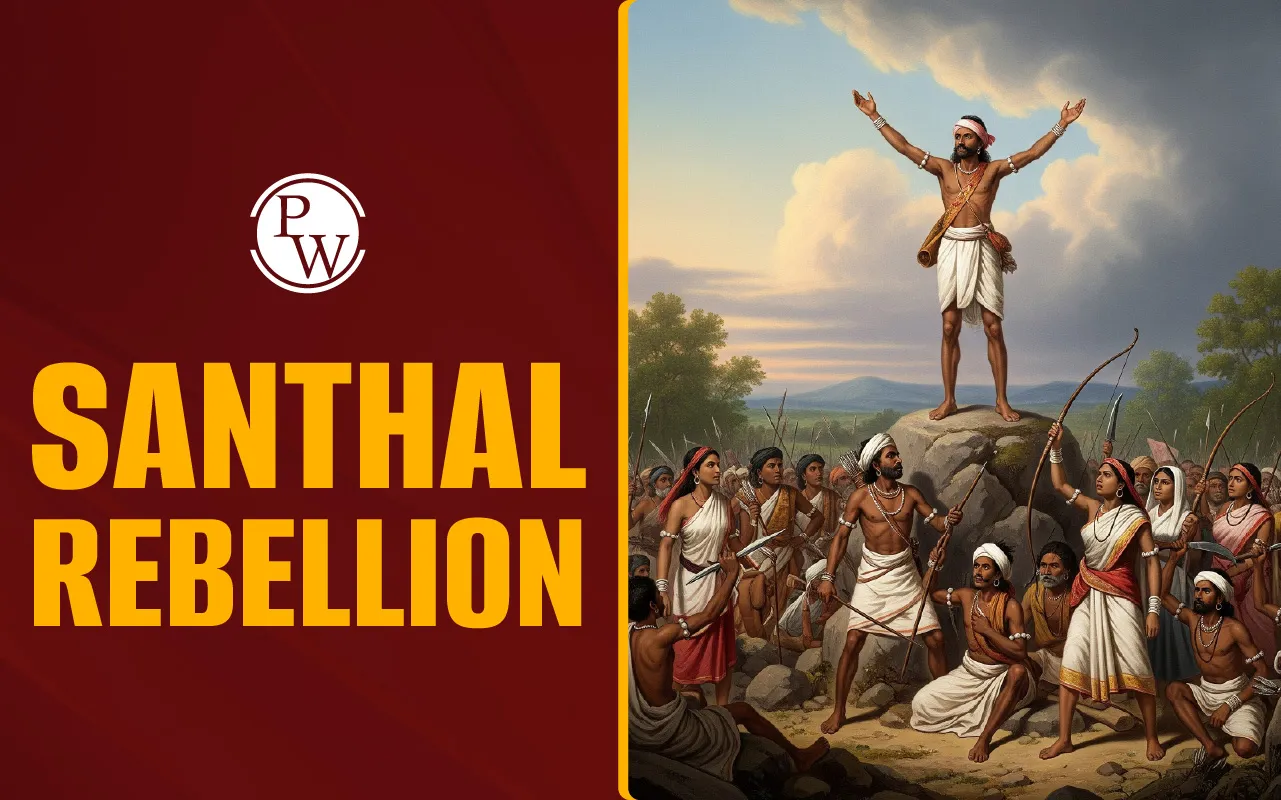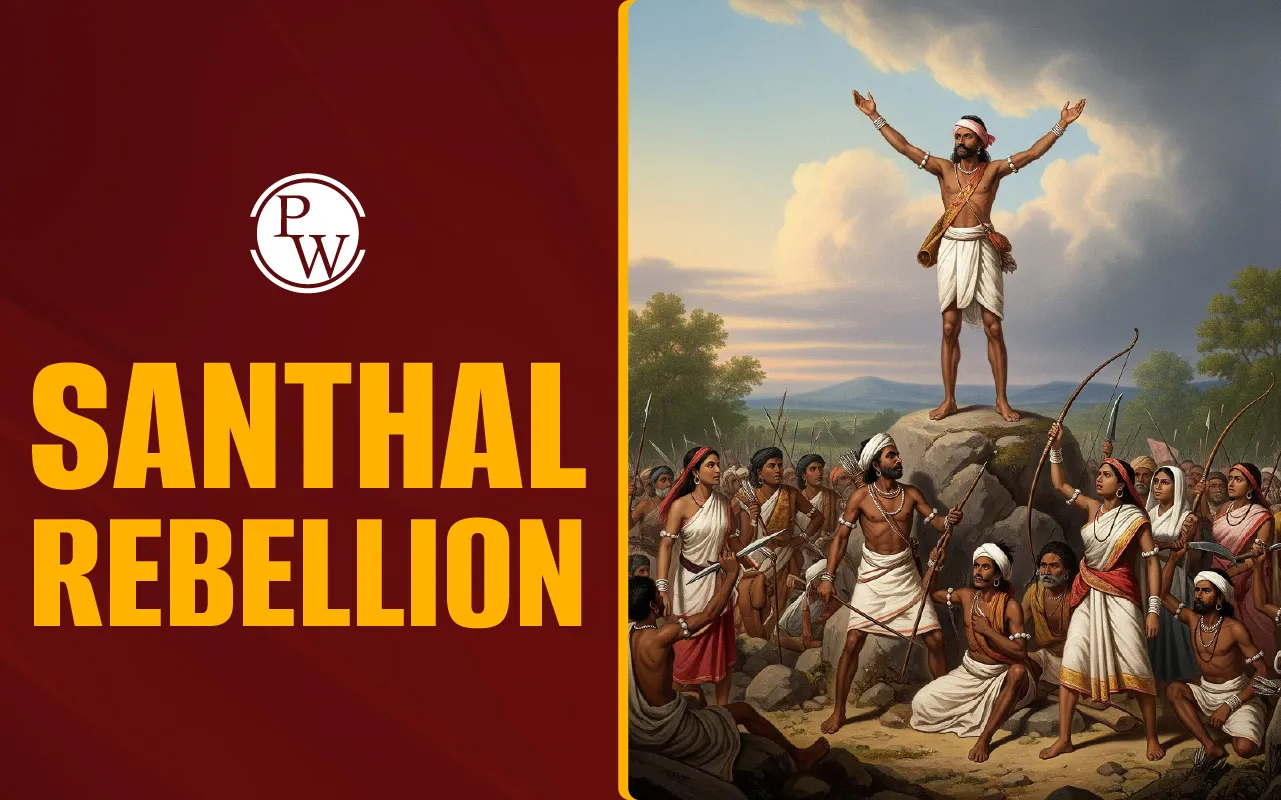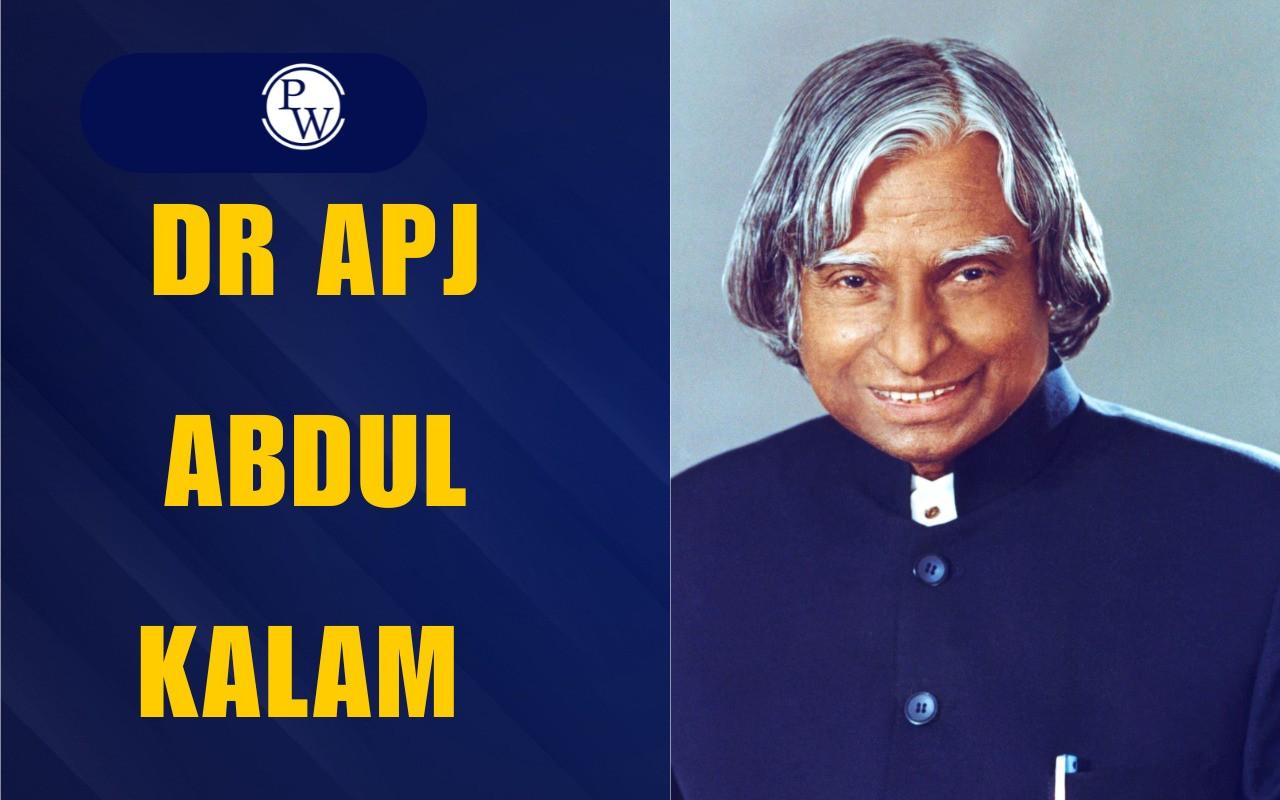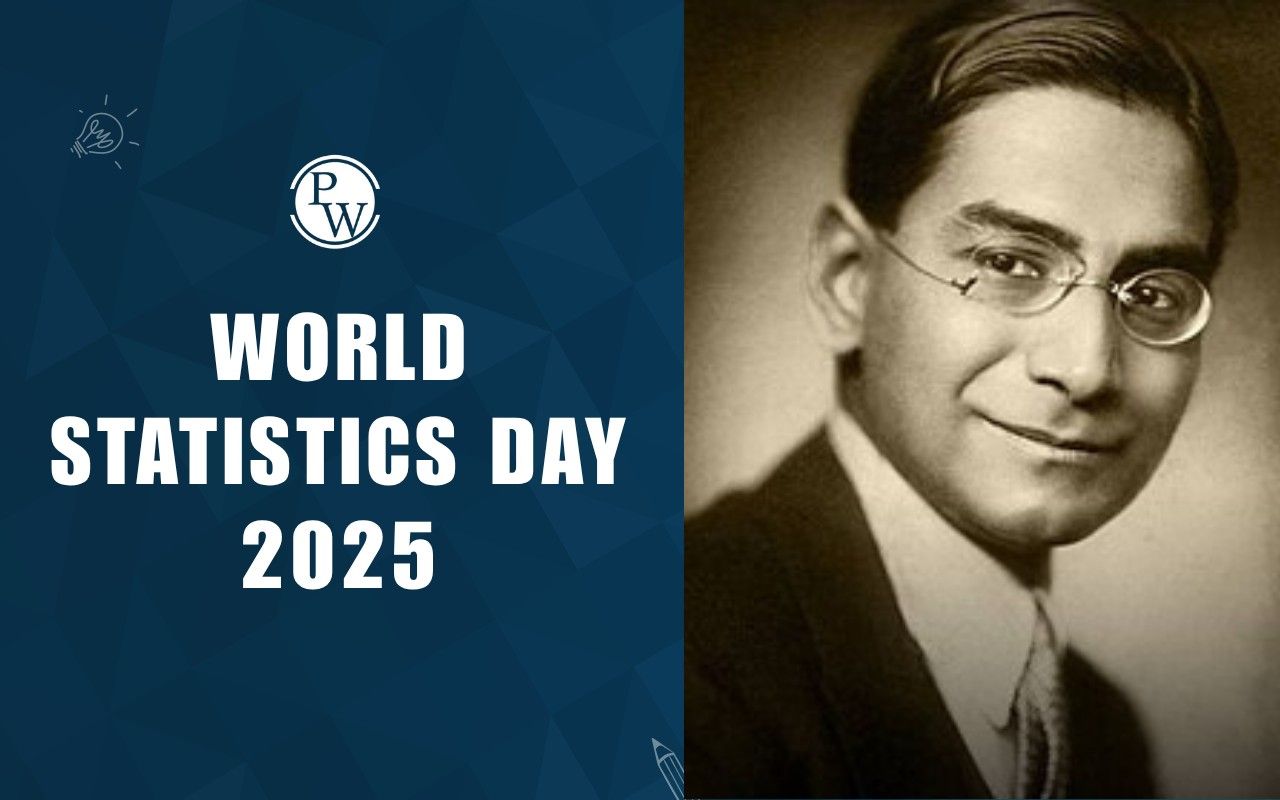

Santhal Rebellion (1855–56) was one of the earliest tribal uprisings against British rule and oppressive landlords in India. It took place in Rajmahal Hills, located in the present-day Jharkhand, then part of the Bengal Presidency. In this revolt, thousands of Santhal Adivasis took up arms to fight injustice, exploitation, and harsh colonial laws. Read for more information on the Santhal Rebellion!
What Was Santhal Rebellion?
The Santhal Rebellion, also known as the Santhal Hul, was a significant tribal uprising that took place in 1855–1856 in British India. It was led by the Santhal community under four brave brothers, Sidhu, Kanhu, Chand, and Bhairav, against the British colonial authorities and their local allies, such as landlords and moneylenders (zamindars and mahajans).
Though the rebellion was brutally crushed, it left a lasting mark on Indian history. It forced the British to rethink their policies towards tribal regions and led to legal reforms. Today, the Santhal Rebellion is remembered as one of the earliest organized resistance movements against British rule in India.
Background of Santhal Rebellion
The Santhal rebellion erupted in the Rajmahal Hills, particularly in the region called Damin-i-Koh. The Santhals had settled there under a British scheme introduced in 1832. The plan aimed to clear forests and bring new land under cultivation. The Santhals worked hard to turn the area into fertile land.
However, their peaceful life was disturbed when zamindars (landlords), moneylenders (mahajans), and British officials started exploiting the tribal people. They imposed heavy taxes, forced them into debt, and punished them harshly for defaults. Slowly, anger built up, leading to one of the fiercest revolts in tribal history.
Who Were the Santhals?
The Santhals are one of India’s largest tribal communities. They mainly live in Jharkhand, Odisha, Bihar, and West Bengal. Santhals follow their own traditions, culture, and language, Santali. They are nature lovers and worship natural elements like hills, forests, and rivers. They lived in close-knit communities and followed tribal governance.
Before British rule, they lived freely in forests and cultivated land without interference. But under colonial rule, their autonomy was crushed. The Santhals were pushed into slavery, debt, and oppression, which eventually led to the rebellion.
Causes of the Santhal Rebellion
Several factors caused the Santhal Rebellion:
-
Land Alienation: The British allowed outsiders like zamindars and mahajans to grab Santhal lands, and they lost ownership rights.
-
Exploitation by Moneylenders: Mahajans lent money at high interest, due to which many Santhals became bonded labourers with unpaid debt.
-
Harsh British Revenue Policies: British imposed land taxes that the Santhals could not afford.
-
Police and Judicial Oppression: The police and courts sided with the landlords and punished Santhals unfairly.
-
Cultural Threat: Santhal traditions, festivals, and governance were ignored, and their lifestyle was under attack under modern policies.
-
Loss of Forest Rights: They were denied access to forests, which were essential for their survival.
These conditions created frustration and triggered a strong call for rebellion.
Key Leaders of the Santhal Revolt
The Santhal Rebellion was led by a core group of four Santhal siblings:
Sidhu Murmu and Kanhu Murmu
Hailing from Bhognadih village, Sidhu and Kanhu Murmu were the main leaders of the Santhal Rebellion. They united thousands of Santhals, organized large-scale gatherings, and boldly declared independence from British rule. They also set up an alternative system of governance, assigning roles, distributing titles, and issuing directives to coordinate the rebellion.
Chand Murmu and Bhairav Murmu
As younger brothers of Sidhu and Kanhu, Chand and Bhairav played essential roles in the movement. They were instrumental in mobilizing tribal warriors, planning strategic attacks, and leading combat efforts during the uprising, showing exceptional courage and organizational skill.
Phulo Murmu and Jhano Murmu
The sisters of the Murmu brothers, Phulo and Jhano, are honored for their fearless involvement in the rebellion. They reportedly infiltrated enemy camps and fought alongside their brothers on the battlefield. Their martyrdom became a symbol of Santhal resistance and women’s role in the struggle for justice.
Major Events in Santhal Rebellion
The rebellion started in June 1855 when Sidhu and Kanhu called for a mass uprising at Bhognadih village. They declared freedom from British rule and started attacking symbols of oppression. Here are the key events of the Santhal Hul:
| Event | Date | Highlights |
| Revolt Declared | June 30, 1855 | 10,000+ Santhals, led by Murmu siblings, declared revolt at Bhognadih against the British & zamindars. |
| Guerrilla Warfare | Mid-1855 | Santhals used guerrilla tactics and seized areas between Bhagalpur & Rajmahal, attacking colonial targets. |
| Panchkatiya Clash | July 7, 1855 | Santhals killed 8 police, including the chief, during an arrest attempt. Conflict escalated. |
| Rebellion Spreads | Late 1855 | Attacks on exploiters, communication lines disrupted; local support from villagers. |
| British Crackdown | Nov 10, 1855 – Jan 3, 1856 | Martial law was imposed, and ~15,000 Santhals were killed, and villages were destroyed. |
| Aftermath | 1856 onward | Rebellion crushed with leaders dead or captured; Santhal Parganas Tenancy Act passed in 1876. |
Though the rebellion failed militarily, it left a strong message against colonial injustice.
Consequences of the Santhal Revolt
The Santhal Rebellion led to serious consequences both locally and nationally:
-
Heavy Casualties: Around 15,000 Santhals were killed, and more than 10,000 villages were destroyed during the suppression.
-
Administrative Changes: The British realised the need for better tribal administration.
-
Creation of Santhal Parganas: In 1855, the British carved out Santhal Pargana by the Sonthal Parganas Act (Act 37 of 1855) from parts of Bhagalpur and Birbhum to improve tribal governance.
-
Legal Reforms: The Santhal Parganas Tenancy Act of 1876 was introduced to protect tribal lands from outsiders.
-
Social Impact: The rebellion exposed the oppressive nature of the zamindari system
Impact of Santhal Rebellion on Indian History
The Santhal Rebellion had a lasting impact on Indian history and tribal rights:
-
Inspired Other Tribal Movements: The rebellion encouraged other tribal groups to stand up for their rights in different parts of India.
-
Marked the Beginning of Tribal Resistance: It was one of the earliest organised tribal revolts before the 1857 Revolt.
-
Exposed Colonial Exploitation: It highlighted the cruelty of the colonial system and its failure to protect indigenous communities.
-
Strengthened Nationalist Movements: Leaders of future freedom movements studied tribal uprisings like this to mobilise rural masses.
In essence, the Santhal Rebellion was more than just a tribal revolt. It was a fight for justice, identity, and dignity. Though the rebellion did not succeed, it awakened India to the power of unity and the need for freedom.
Want to understand more such historic events deeply? Enrol in UPSC courses by Physics Wallah and begin your preparation today!
Santhal Rebellion FAQs
What was the purpose of the Santhal Rebellion?
Who led the Santhal Rebellion?
In which state did the Santhal Rebellion take place?
What was the date of the Santhal Rebellion?
Why is the Santhal Rebellion important for UPSC?

UPSC Coaching












